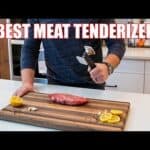Beef’s tenderness is the most important factor affecting consumer ratings. And needle tenderization is one of the way to make it happened. Tenderness of beef is influenced by two factors: background tenderness and protein (muscle fiber) tenderness.
Each cut will have varying amounts and types of connective tissue that will determine background tenderness. Tenderloin normally stays tender unless it is cooked properly, whereas brisket typically gets tough unless it is cooked properly.
Brisket and tenderloin differ greatly in the amount and type of connective tissue they contain. Brisket has more and tougher connective tissue, while tenderloin has less and softer connective tissue.
Protein or muscle fiber tenderness is influenced primarily by the strength of the meat fibers, which are influenced by aging (holding meat in an unfrozen state). As meat ages, muscle fibers weaken because enzymes break apart the fibers, resulting in increased tenderness. Because muscle fibers weaken during aging, steaks aged 14 days are generally more tender than steaks aged 3 days.
Needle Tenderization
The needle tenderizing method involves piercing the meat with a set of needles or blades, cutting through muscle fibers and connective tissues. The needle tenderization process can be applied to wholesale cuts like whole ribeye rolls or shoulder clods, as well as to individual steaks and roasts. When needle tenderization is used on wholesale cuts, it is called “needling” or “needling.” However, when steaks are needle tenderized, it is called “Jaccarding.” The JaccardTM company makes needle tenderization devices commonly used at homes and in restaurants
A mechanical tenderizing process can greatly enhance both the flavor and tenderness of beef cuts.Needless to say, needle tenderization can reduce variability and improve the tenderness and palatability of beef cuts. As with any process, mechanical tenderization must be properly used to ensure the best outcome.
Proper use of Needle Tenderization
Subprimals are usually needle tenderized at the processing plant or processor (purveyor) level. Needles for tenderizing large cuts are generally expensive and large pieces of equipment.
The figure 3 shows an example of a needle tenderizing machine. There are four questions that need to be answered regarding needle tenderization: 1) Which cuts should be needle tenderized; 2) When should a cut be needle tenderized; 3) What is the proper procedure for mechanically tenderizing beef cuts; and 4) Does needle tenderization result in any quality problems? Research and industry experience have provided answers to each of these questions.
Proper Procedure for Needle Tenderizing Beef Cuts?
There are several factors that can be controlled during needle tenderization, including how often the blade enters the meat and how long it stays there. A conveyor speed can be adjusted to increase or decrease the number of times needles enter a cut. Because tenderness improvement was similar between slow and fast conveyor speeds, shear force values of inside round were not affected by conveyor speed.
In addition, the number of times a cut is tenderized is not particularly important. Cooked steaks from the eye of round and tenderloin were more tender after one pass through a blade tenderizer. Increasing the number of passes through the tenderizer does improve tenderness; however, these improvements are marginal and likely not worth the added time and cost. One pass through a needle tenderizer at medium to fast conveyor speed is sufficient to improve the tenderness of most cuts. A second or third pass through the tenderizer may improve tenderness further, but it is not generally necessary.
Are there any quality problems associated with needle tenderization?
Needles have been shown to cause very few quality problems with tenderization. Researchers have examined purge loss during packaging, cooking loss, and display life of needle tenderized cuts and have found only minor differences. The needle tenderized inside round has been found to have an improved cooking yield according to some studies. Purge loss may increase slightly due to needle tenderization, but the difference is small (< 1%). The display life is also not affected by needle tenderization, with minimal changes in fresh color occurring during display.
Cubing (Maceration) and pounding are very effective methods of improving the tenderness of beef steaks. Cubing uses small blades on rollers to completely macerate the surface of the steak, changing it completely from the outside in. Because the equipment used to cube steaks can only process them, cubing is only effective for steaks. Beef is often cut into very tough cuts such as inside round steaks, but it is also used for knuckle steaks, chuck tender steaks and more. Looking for the best meat tenderizer? we have a review you can check.
Cubing is often done at retail since the disruption of the surface results in a reduced display life. Some small meat shops cube round steaks and freeze them. The process of cubing is used to make products such as Swiss steak or chicken-fried steak. Cuts such as ribeyes, tenderloins, and many value cuts are not suitable for cubing. Pounding accomplishes the same result as cubing and is usually done at home with a meat hammer.
Was this helpful?
Hi there! I’m a food enthusiast and journalist, and I have a real passion for food that goes beyond the kitchen. I love my dream job and I’m lucky enough to be able to share my knowledge with readers of several large media outlets. My specialty is writing engaging food-related content, and I take pride in being able to connect with my audience. I’m known for my creativity in the kitchen, and I’m confident that I can be the perfect guide for anyone looking to take their culinary journey to the next level.









